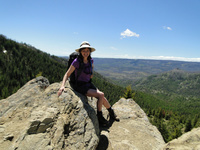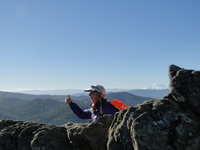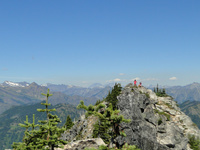How to prevent falls on steep descents
After reaching their goal- hiking to a summit or ridge- people feel tired and mentally relax. Descending is most dangerous part of trail running, hiking and climbing. We tend to hurry, eager to get home.
Light is fading. The steep trail is tricky underfoot with protruding roots, slippery mud and rolling rocks.
To Prevent Falls
-
In steep areas, walk downhill in a zigzag pattern like a skier carving turns. This turns your feet sideways on the hill. it's more stable.
-
Slow down.
-
Karen taught me to take rapid, small steps downhill.
-
Lift up your feet.
-
STOP your feet before looking at the view. Every time I forgot this, I tripped.
-
Lengthen hiking poles for the descent. Often hiking poles stop me from falling.
-
When it's too steep to stand, I sit down and do a controlled slide until I can stand up. On snow, shale, mud or small rocks. Safety is more important than my pants and pride.
About once every two years, I trip on a rock or protruding root and fall, driving my knees, face and hands into the rocky trail. I instinctively throw my body toward the hill to avoid going over a cliff.
Then I put on my headlamp.

Enjoy being online again!
Welcome to the community of good people who base their values on evidence and appreciate civil discourse - the social network you will enjoy.Create your free account
6 comments
Feel free to reply to any comment by clicking the "Reply" button.The first three work well for going up hill too.
You're right.
This is very good advice whether hiking, climbing, or just in one of our icy winters.
Thank you.
There is a great deal of beauty in those photos! 
I took a tumble coming down off of Mount Adams in the White Mountains of NH and had to dig out my first aid kit to patch up my arm and leg (it was all rock where I was walking). When I got back to the parking lot at the bottom of the trail I saw some guys talking by a car and one of them was wearing twice as many bandages as me so I didn't feel so bad about my fall.
Enjoy being online again!
Welcome to the community of good people who base their values on evidence and appreciate civil discourse - the social network you will enjoy.Create your free account
Share this post
Categories
Agnostic does not evaluate or guarantee the accuracy of any content. Read full disclaimer.










